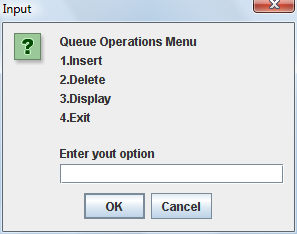
To prevent any concurrency issues and side effects due to multithreading, all of the ArrayBlockingQueue methods are protecting its operations with a thread lock.Īs we can see in the above two examples each operation starts with locking a reentrant lock, and each operation finishes with unlocking that lock. The ArrayBlockingQueue uses a bounded cyclic buffer backed by a fixed-size array to store its elements. One implementation of the queue data structure that solves both of those concerns out-of-the-box is ArrayBlockingQueue, which is part of the package. Additionally, we need to prevent any thread that attempts to add more elements to the queue from succeeding, which can be achieved by blocking that thread. To prevent this from happening we need to set an upper bound for the number of elements we can store in our queue at any given moment. When the number of elements in our queue grows uncontrollably to the point that we exceed the JVM’s heap size, our application may crash due to an OutOfMemoryError exception, which is generally unrecoverable.
#Poll java queue how to
If you want to learn how to efficiently solve such challenges while providing your Java application with high performance make sure to check out Java Multithreading, Concurrency, and Performance Optimization online course. By trying to solve these Java Multithreading problems, developers who aren’t proficient in Java Multithreading and Concurrency may cause even more problems in a form of deadlocks or performance bottlenecks due to inefficient and excessive locking.

A few of those side effects include race conditions, data races and others. When working with a data structure that isn’t inherently thread-safe, many undesired side effects may happen when the data structure is accessed and modified by multiple threads.

In a Java multithreaded production application environment, two concerns need to be taken into account when choosing a concrete implementation for the queue data structure. Queue in a Multithreaded Java Application Producer - The thread that adds elements to the queue by calling the enqueue operation.Ĭonsumer - The thread that removes elements from the queue by calling the dequeue operation.ĭepending on the use case there may be multiple producer threads and or multiple consumer threads. In the context of multithreaded Java applications there are 2 types of actors performing operations on a queue: In the Java Queue interface, this operation is represented by the remove(), and poll() methods.

In the Java Queue interface this operation is represented by the add(), and offer() methods.ĭequeue - remove an element from the front of the queue. When it comes to operations we can perform on the data structure, the two most important ones are:Įnqueue - add an element to the end of the queue. At each invocation it removes the first element of the list and if the list is already empty it returns null but does not throw any exception.Before we talk about Java Multithreading and the specific ArrayBlockingQueue implementation, let’s define a few terms that are commonly used to describe operations and actors in the context of a Queue. This method retrieves the value of the first element of the queue by removing it from the queue. however, if the list is empty element() throws a NoSuchElementException. This method behaves like peek(), so it again retrieves the value of the first element without removing it. If the queue is empty the peek() method returns null. For each invocation of the method we always get the same value and its execution does not affect the size of the queue. This method retrieves the value of the first element of the queue without removing it from the queue. The Queue interface defines some methods for acting on the first element of the list, which differ in the way they behave.


 0 kommentar(er)
0 kommentar(er)
